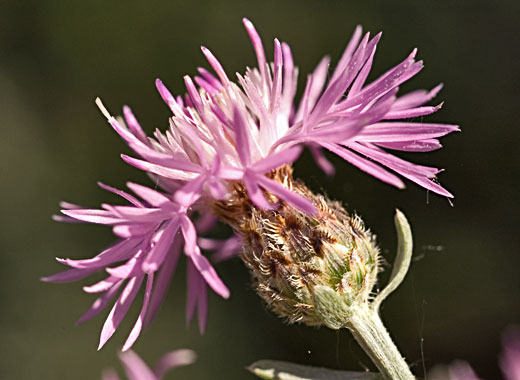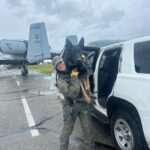COMMENT: Dead bears, nature-illiterate moderns, and the knapweed bloom
Our report last week on “Li’l Cinnamon”—the black bear runt who’d learned to forage in human property and so was caught and killed by conservation officers—generated a lot of interesting discussion. Les Anderson’s comments struck a particularly harmonious chord for me: “Humans have no understanding of wild animals whatsoever,” he wrote, “so they turn to spreading fear mongering about them.”
I first met Les at Café Books where he told a tightly-packed crowd about his fascinating experiences as a boy raised in Saskatchewan’s far north, living in large part off the land as his family only received one or two resupplies each year. He wrote last week, “We learned very early in our childhood to understand a black bear’s subtle language and how to behave around them, and what to do if we were confronted by any aggressive animal, especially black bears.”
“Sadly, this bear was destroyed for no other reason than simple ignorance of what we need to know when living in areas that are frequented by wild animals,” he continued. “Not understanding their body and simple vocal language base is also lacking in our dealing with them.”
He concluded, “My greatest concern is how humans react to bears and actually create dangerous bears because of their own phobias and misguided beliefs.”
I agree, Les. I also worry that there are many natural modes of communication that most modern humans have forgotten, and how to read a bear’s complex—but emotionally and intuitively simple—personality and body language is just one. Many other deeply harmful misrepresentations of nature are perpetuated by well-meaning but sorely misguided moderns.
“Invasive plants” are one. Take spotted knapweed, whose pink-fuzz flowers are just now coming into bloom. This plant is fundamentally the symptom of a soil condition, and usually a human-created soil condition at that, but organizations such as the Central Kootenay Invasive Plant Committee (CKIPC) insist on blaming the weed.
The CKIPC write, “The invasion of spotted knapweed impacts wildlife, including ungulate winter range habitat. This species forms monocultures that displace native plants and reduce biodiversity, including habitat for the western skink and other threatened animals. As well, spotted knapweed reduces the grazing capacity of land, impacting ranchers and the agricultural community.”
Let’s flex an analogy: If you grab a knife by the blade and bleed, do you blame the blood—and then do it all over again? “Stupid blood,” you might say, while the knife digs deeper.
So why do we trash the soil and blame the weeds, and then do it again and again?
If you don’t want knapweed, there are many helpful solutions, all of which improve the soil. Knapweed only grows in relatively dry, infertile, disturbed sites, so regular watering helps to start. More directly, graze the weed with goats, fertilize the land with goat outputs—that’s right, you know the ones—and each spring sow a super-diverse mixture of seeds. Change takes years, but the diversity will return.
No goats? Then regularly mow the site, spray regularly with compost tea, and watch the ecosystem change like magic, season over season. This is a very efficient way to cover a large area with widely available industrial equipment—in this case, a bush hog, a bubbling vat of dirt cheap compost tea, and an orchard-scale sprayer.
To heal our Earth quickly, many “natural” methods can be adapted to a large scale using industrial equipment. So what’s holding us back? I don’t know.
There are also officially recommended “biological control” methods for knapweed—namely, introducing insects that parasitize the plants—but these treat the symptoms and do nothing to address the fundamental cause: dry, infertile, disturbed soil.
Granted, there are naturally dry, infertile ecosystems where native species adapted to these conditions are being crowded out by knapweed. This is exactly where biological control makes a great deal of sense. But ranches and road verges hardly count as native landscape, and if we’d treated these lands better in the first place, knapweed would hardly have become a problem for the native ecosystems.
In the meantime, while the knapweed’s growing, why not take advantage of it? Put out some beehives, for one. The lovely flowers are a favourite nectar source.
And knapweed’s strong taproot accumulates goods from deep soil horizons and brings these minerals and nutrients back to the surface—that’s why regular knapweed mowing or grazing helps “pump up” the soil, both in organic matter and yummy soil goodies.
Instead, however, modern humans vilify knapweed as an “invader” and choose the path of war based on prejudicial and narrow frames of mind.
At great expense (and profit to chemical companies) taxpayers fund highway crews to spray the dry, infertile roadsides with herbicides. The poisons kill all the life that would otherwise help heal the soil. The “cure” perpetuates the soil problem and the symptom: “invasive aliens.” Consequently, the weeds develop an “unkillable” reputation, but it’s just that a stupid method is used over and over again with predictably lousy results.
Most ranches have this mental problem too. Rather than change their grazing practices—by adding goats and sheep to the mix, along with the horses and cows, by grazing small areas intensively and sequentially, by seeding ultra-diverse hay mixtures, by irrigating, and (if possible) by applying compost—ranchers seem to prefer to hate and blame the weed that is largely a consequence of their “nature illiterate” farming system.
We sure like having enemies to blame so we can fight expensive wars. As far as I’m concerned, we shouldn’t fight bears or knapweed or Afghanis. Our ignorance of nature is enemy number one, a villain that truly deserves to be slain.

























Comments